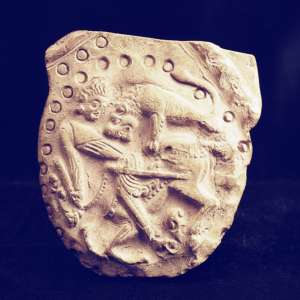
|
TILE WITH THE SCENE OF HUNTING LEO.
The fired clay. 14 x 13 (thickness 1,5-2). Image is printed by stamp and to the kilning (fragment of some large article). Rider, going to the left, is inverted back to the side of the lion that tears the croup of horse. It is clear that the detail of the vestments of rider and horse harness, mane, paw and vortex rosette on the arm of lion were examined. Impression is bounded above by the narrow depressed groove, to the right - by relief plait with the narrowing; furthermore, it frames the circle, formed by the depressions of hollow circles. Judging by the arrangement of figures, composition was created for the reproduction in the circle (for example, in the locket). 7C Лит.: ЮТ № 251.
|
thumbnail size : 300x300 (12,585 bytes)
|
|
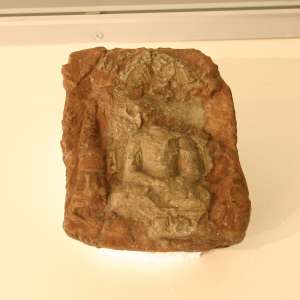
|
SITTING BUDDHA (statue on the tile).
Red and green clay. 15.5 x 13 x 6. Printed by die itself Buddha (hands in the position of dhyana-mudra) in the green clay; arch-niche, pedestal, Stupa (or Stupas?) and the remaining part of statue is in the red clay. It is found in 1964 in corridor of XXVII - in the filling of niche № 1 (XXVII/3-2). РТЛ-95. Лит.: ЮТ № 255.
|
thumbnail size : 300x300 (8,792 bytes)
|
|
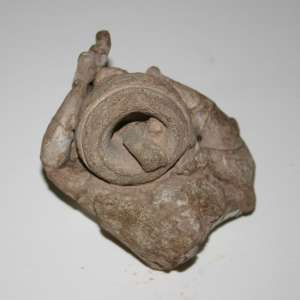
|
HAND with THE BELL (fragment of sculpture only less than the actual size).
Clay with the traces of white paint. 12 x 7.5 x 5.5. The bell of hemispherical form with the suspension tongue and the triple eyelet for the suspension is grasped in the palm of right hand. White paint covered bell and partially fingers. 1971, in the filling of monastery court (ДМ/С-5). РТЛ-118. Лит.: ЮТ № 297.
|
thumbnail size : 300x300 (7,372 bytes)
|
|
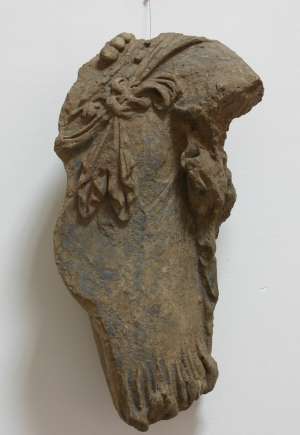
|
TORSO OF SECULAR CHARACTER (2 fragments).
Clay with trace of paint. 41 x 20 x 12 and 17 x 10 x 10. Character composed the part of the high relief composition, in which he was faced to the spectator by left side. Blue pleated clothing covers trunk and part of the arm; the red scarf, tied by bow, is thrown on above it on the arms. On the neck is necklace from the pearls (white round beads) and gold (yellow) - Grivna-necklace.
РТЛ 1971, in the filling of monastery court (ДМ/С-1 и -1а). Лит.: ЮТ № 270.
|
thumbnail size : 300x435 (11,390 bytes)
|
|
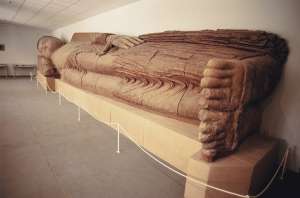
|
The Buddha's restoration : a 40 years long history
After its excavation (of Ajina-Teppe) and conservation in the field, the sculpture of 'Buddha in Nirvana' which was divided into 44 parts, was transferred to Dushanbe to the Academy of Science of Republic of Tajikistan's laboratory of Restoration and Ethnography (laboratory supervisor L.novikova). The restoration of the sculpture has been a long and and difficult process.
In the middle of the 90's the National Ermitaj joined the restoration (V.Fominikh began the work). In 2000, after the completion of the State Museum of the Antiquities' construction appeared an opportunity to assemble and set up the sculpture of "Buddha in Nirvana". Under V.Fominikh's supervision, restorers and Museum staff began erect the sculpture. In the project of assembling the sculpture and completing the restoration, the institute of History, Archaeology and Ethnography of AS of RT (director R.Massov) cooperated with the French Archaeology Mission in Tajikistan (director R.Besenval, CNRS Guimet Museum) and the NGO ACTED (director F.Roussel).
The restoration of the Buddha was completed for the opening of the State Museum of Antiquities of Republic of Tajikistan in September 2001 during the course of Tajik Republic's celebrations for the 10th anniversary of ondependence.
|
thumbnail size : 300x198 (6,948 bytes)
|
|
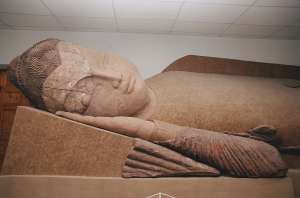
|
The Buddha's restoration : a 40 years long history
|
thumbnail size : 300x198 (6,875 bytes)
|
|
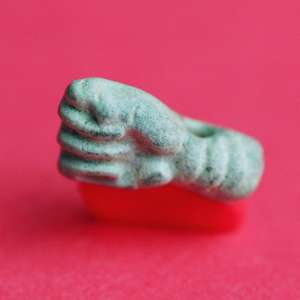
|
HAND OF BUDDHA (fragments of Buddha's statue in the nirvana).
Clay with the traces of white paint. 305 x 125. Forearm and palm of left hand were exposed. 1971, Room № 23 (XXIII/С-1).
|
thumbnail size : 300x300 (5,596 bytes)
|
|
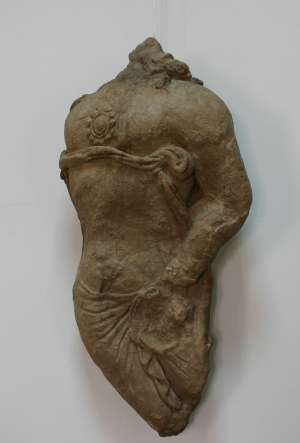
|
TORSO OF DEITY.
Clay. 75 x 35. The lower part of the trunk is shut to dkhoti, breast is tightened by braid cord, from the neck to the breast the adornment hanged down. Person was the part of the very ornate high relief of composition - the number of the half-naked characters, faced to the spectator into a fourth of revolution. 1967, Room № 23 (XXIII/С-3). РТЛ-9. Лит.: Литвинский - Зеймаль Т. 1971, илл. 38, 39; ЮТ № 276.
|
thumbnail size : 300x443 (9,584 bytes)
|
|
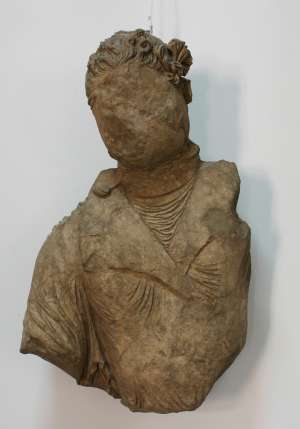
|
TORSO OF SECULAR PERSON IN THE CAFTAN.
Clay with the traces of paint. 70 x 44 x 13,5. Head and upper half of body and part of the arm of right hand were preserved. Double-breasted caftan (or dressing gown?) is adjusted to the left; on the waist, the breast and the arm there are small folds. In the triangular neckline on the neck is visible the lower clothing, whose frequent horizontal folds go highly to the neck. The front of the head is lost; short black wavy strands disperse by fan from the forehead; in temples the hair are caught by the yellow bandage, tied by the bow above the left ear. 1968, Room № 28, it is immured during the repair of the wall of corridor (XXVIII/С-1). РТЛ-79, 80.
Лит.: ЮТ № 289.
|
thumbnail size : 300x429 (11,105 bytes)
|
|
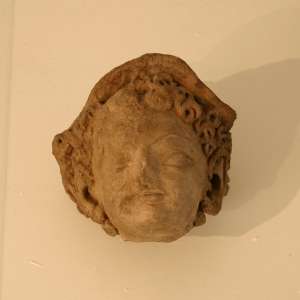
|
HEAD OF CHILD.
Clay with the traces of paint. 12,5 x 12 x 12,3. Facial mask is executed by die, the remaining details (curls of black hair, ear, cap) were pasted by hand. Head was calculated for the survey from all sides. Only the tracks of the coloring were preserved: on the cap and on the eyelids is blue paint, in the fold of neck under the chin and inside the auricle is red. 1968, Room № 28, it is immured during the repair of the wall of corridor (XXVIII/С-2). РТЛ-18.
Лит.: ЮТ № 296.
|
thumbnail size : 300x300 (6,197 bytes)
|
|
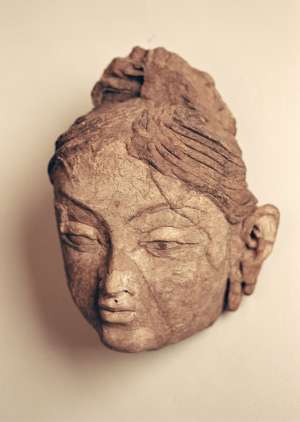
|
HEAD OF NOBLEWOMAN.
Clay with the remainders of paint. 20.5 x 15.5 x 11. Technology of production usual for the sculpture of Ajinatepa: facial mask is printed in the matrix with the afterward making modification of together; the ear stamped separately is stuck so that the seam is visible. The coloring is well visible on the surface of the preserved front: face was white, thin eyebrows black; eyes are supplied blue, the pupil is black; red paint is in the deepening of the auricle and on the lips. The long black hair, divided by parting, are assembled on the top into hair worn in knot. On the forehead, above the bridge of the nose, small pit- Urna is filled with red paint. Judging by the light asymmetry of the person, character was faced to the spectator by left side. 1971, it is found near the right pylon of the stairs of the northwestern front of main Stupa, it was hidden under coatings of the floor of court during the functioning of monastery (ДС/С-21). РТЛ-99. Лит.: ЮТ № 295.
|
thumbnail size : 300x422 (11,747 bytes)
|
|
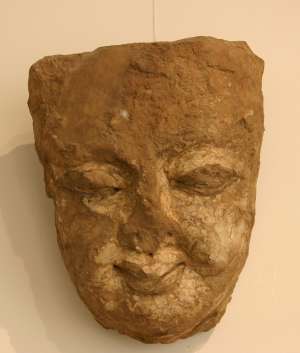
|
HEAD OF BUDDHA.
Clay with the tracks of coloring. 37 x 27 x 16. (somewhat larger than the actual size). Facial mask was preserved almost completely (absent hair, the part of the nose is biased, there are losses in right temple and on the forehead). Soft oval of face, rounded chin, the slightly being smiled mouth with the elevated upward corners. Upper lip overhangs the lower, above the upper lip small dimple. Eyes almond-shaped, half covered by eyelids. Superciliary arcs are weakly modeled. The traces of thin white alabaster coating on the surface of face were preserved, eyelids were supplied by black paint. 1975, sanctuary, in the niche of southern wall. 7C - beginning of 8C.
РТЛ Лит.: ЮТ № 313.
|
thumbnail size : 300x353 (10,231 bytes)
|
|
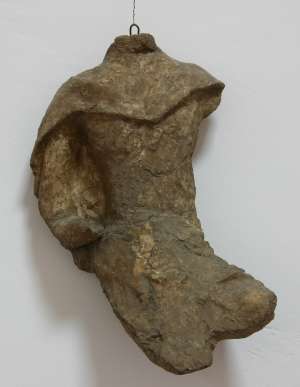
|
THREE STATUES (fragments).
Clay with the traces of paint. Fragments of clay sculpture.
a) FIGURE OF LOKAPALA (three fragments of one figure; 38 x 25 x 13.5; 112 x 45 x 27; 15 x 45 x 61; the reconstructed height corresponds to average human size). From the head to the neck, the facial part was preserved with change (absent hair-do, ears). Face is rounded, is high-cheeked. The arcs of eyebrows are highly raised. Eyes strongly elongated, only they are covered by upper eyelid. Nose small (is partially biased), half-open mouth slightly smiles.
b) TRUNK OF MAN (17,7 x 16,3 x 9,2), which belongs to the small genuflection figure - one of the secondary characters in the high relief of composition (in the attendants of celebrity or in the environment of Buddha). Underclothing covers the lower part of the trunk; stomach, partially breast and hand are exposed; the cover, which is descended to the breast covers arms with triangle. 1975, sanctuary.
Лит.: Литвинский 1983, с. 296; ЮТ № 315.
c) TRUNK OF MAN (80 x 40 x 9,5) in the pleated garment (sanghati?). Folds on the stomach and around the neck are molded relief, small semicircular folds on the breast are drawn together, on the damp clay very inattentively. 1975, sanctuary, in the filling (initial position is not reconstructed).
Лит.: ЮТ № 316.
|
thumbnail size : 300x387 (9,425 bytes)
|
|
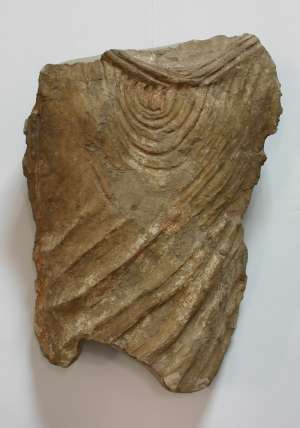
|
THREE STATUES (fragments).
|
thumbnail size : 300x428 (12,946 bytes)
|
|
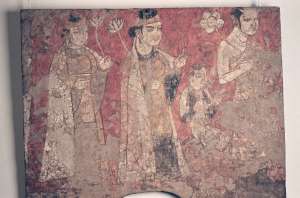
|
SCENE OF PRANIDHI.
Painting by paints on the loess plastering with the sub-priming of alabaster. 78.5 x 102. In the upper tier of the composition (it were preserved its only lower part) there were Buddha in the yellow Sanghati, sitting in the Padma-asana pose on the pillow- throne, twisted by spray with leaves, and two confronting to next figures (Bodhisattva?). In the lower tier, isolated by strip (pearls), is very ornate composition. In its left side two female figures, which stand after each other and turned to the right, in the similar headgear and the clothing, with the gifts in the hands (candle, vessel, and flowers). In front, the figure of man is executed on the same scale and turning. His hair is briefly cut. Body is covered with pleated pink cloth; under it the lower clothing is another color. Right arm and hand are exposed. In the right hand the large flower of lotus on the long stem. On the feet are black boots with the lapels.
The remainders of one additional man figure in the checked (?) yellow clothing are visible in the right side of the fragment. On the second plan, as in the behind scene (and therefore on a smaller scale), are depicted the three additional men: two sit, sat cross-legged, the third stands. Lower pleated clothing is visible from under the tightly covering caftans with the lapels. Waist is fastened by the belts setting with the rings, to which the weapon was hung up. On the feet are soft foot-wear. In the hands of persons are different gifts. 1975, roundabout corridor around the sanctuary.
Лит.: Литвинский 1983, с. 287-295; ЮТ № 316; ЖСТ № 26.
|
thumbnail size : 300x198 (10,159 bytes)
|
|